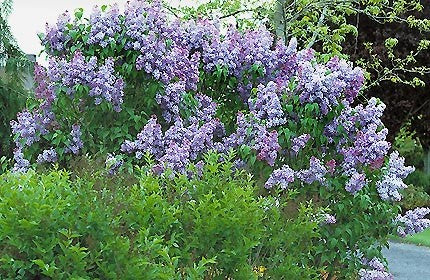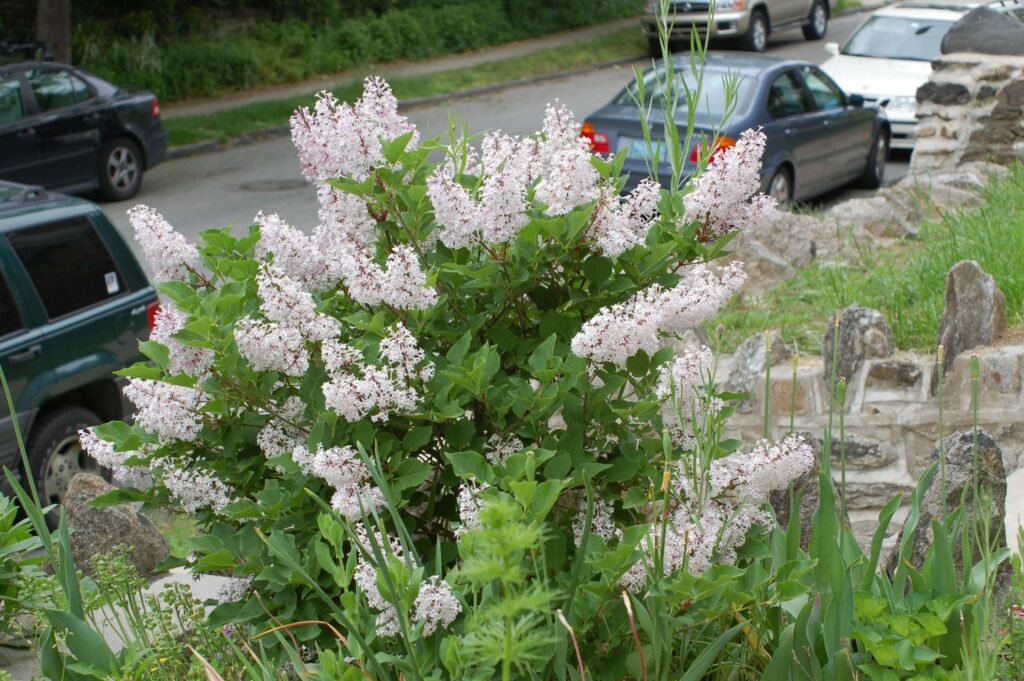by Ken Lain, the mountain gardener
The fragrance will remind you of visits to Grandmother’s house. A truly outstanding lilac for the large flowers and captivating fragrance, and super easy to grow. She is in a class by herself, even in the hottest of sun locations. In fact, the more sun she receives, the more flowers you will have.

Common lilac bushes, Syringa vulgaris, are deciduous shrubs that bloom in the late spring. They are part of the olive family and members of the Ash tree, forsythia, and privet shrubs. The outstanding quality of many lilac varieties is the sweet fragrances of their flowers. The blooms appear in the mid-to-late spring in branching clusters or panicles. The leaves are green to blue in color and grow 2-5 inches long. In autumn, they change to an aspen gold color. The bark is gray in color. The best time to plant lilac bushes is in the early fall before the ground freezes. They have a moderate growth rate of 1 to 2 feet per year.
Botanical Name Syringa
Common Name Bloomerang lilac, reblooming lilac
Plant Type Deciduous shrub
Mature Size 4′ feet x 4′ feet
Sun Exposure 6+ hours full sun
Soil Type Well-drained soil
Soil pH 6 to 8
Bloom Time Spring and mid-summer through fall
Flower Color Lavender, pink, purple
Hardiness Zones 3-8
How to Grow Lilac
Common lilac bushes are so special they are often treated as specimen plants, grown as focal points in the landscape. They can also be planted in rows along property borders and pruned into loose hedges. The ‘Miss Kim’ and ‘Bloomerang’ varieties are small enough for use in foundation plantings.
Soil
All lilacs prefer soil that is rich in organic matter. The soil can be neutral to slightly alkaline. Good drainage is essential; lilacs do poorly in soggy, wet soil.
How to plant
1.Dig hole 2-3 times the width of the container but the same depth.
2. Score the root ball sides and bottom with a utility knife or pruners and place them in the planting hole.
3. Blend Watters Premium Mulch into the native soil at 1 part mulch with two parts soil dug from the hole and pack firmly around the roots.
4. Sprinkle 7-4-4 All Purpose Plant Food around the planting area.
5. Prevent ‘Transplant Shock’ by adding Watters “Root & Grow” to your water at 2-week cycles for the first 2 months.
6. Use the remaining Watters Mulch inside the tree well as a top dressing. This will keep weeds down, insulate roots from heat and cold, and keep the roots moist.
Light
Bloomerang lilac tolerates mountain wind, even on the highest ridgelines. She does best in at least 6 hours of sun; the more, the better. It can tolerate partial shade, but it comes at the cost of reduced bloom.
Water
Water newly planted trees regularly with a garden hose for at least one month (2 months in Summer). Automatic irrigation systems may not be sufficient initially. Water frequency will vary according to season, exposure and plant size.
April – Oct Lilac should be irrigated 2 x weekly
Nov – Mar Lilac should be irrigated 2 x monthly
Fertilizer
Feed 4x Times per Year with either 7-4-4 All Purpose Plant Food, Soil Sulfur, or Humic. Here’s the recommendation by season:
Spring = 7-4-4 All Purpose Food + Soil Sulfur
Summer = 7-4-4 All Purpose Food + Humic
September = 7-4-4 All Purpose Food
December = 7-4-4 All Purpose Food
Temperature and Humidity
Like most lilacs, Bloomerang needs an extended period of cold winter, making it perfect for cold mountain landscapes. In areas with hot (100+ degree) summers, lilac blooms longer in locations that provide some shelter from the strong afternoon sun. Summer monsoon rains encourage this shrub to rebloom.
The shrub is not affected by humidity unless the weather is sweltering and humid, which will slow down the reblooming.
Pruning
Pruning is critical for lilacs, promoting flowering and ensuring air circulation to prevent powdery mildew and other issues. The right time to prune is just after blooming is over, as lilacs bloom on old wood. Prune branches to thin growth for better air circulation. This also keeps the shrub’s height at the desired level. Cut off the dead flowers when they are done blooming. This prevents seed from forming and promote more profuse flowering the next spring.
Varieties of Lilac
Several types of lilac bushes vary somewhat in appearance:
- Wedgewood Blue – This compact lilac variety attains a height at maturity of 6 feet with an equal spread. The flowers are contained in thick clusters of lavender blue. It thrives in zones 3-8.
- Yankee Doodle – A small lilac bush with deep purple, fragrant blooms, and more cold-hardy than the main species, suitable for zones 2-8. It grows 8′ feet tall and 6′ feet wide.
- Belle de Nancy – This variety has double pink flowers (multiple layers of petals) and grows 8′ feet tall and 6′ feet wide. It blooms in late spring and prefers zones 3-9.
- Madame Lemoine – Blooming with bright white double flowers, this lilac stands tall at 10’+ feet high and 8′ feet wide. Ideally grown in zones 3-8.
- Primrose is a standard-size lilac that grows 10′ feet tall and 7′ feet wide. It is notable for its yellow flowers that still deliver the beloved sweet lilac fragrance. It is suitable for zones 3-7.

Propagating Lilacs
Anyone who has grown lilacs knows how readily they expand. Most lilacs are clumping plants that spread via shoots extending from the trunk. To propagate lilacs, simply dig down around one of the shoots and cut it from the main plant, keeping the roots intact. Then, replant the shoot wherever you wish, and keep its soil lightly moist at all times until established.
Common Pests/Diseases
All lilacs are deer and javelina resistant. Bloomerang lilac is more resistant to powdery mildew and leaf spots than common lilac. Because powdery mildew, a fungus, thrives in humid weather, ensure good air circulation in and around your Bloomerang lilac by giving it enough space.

